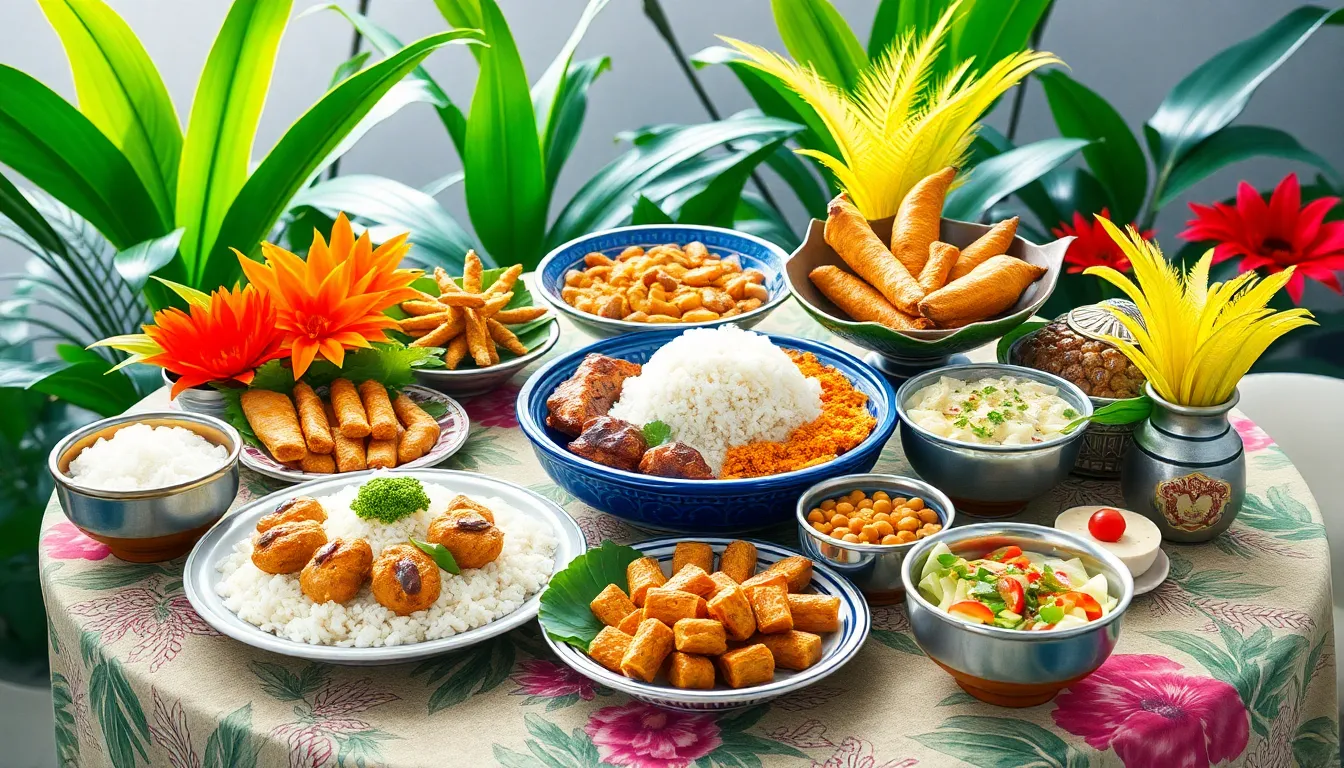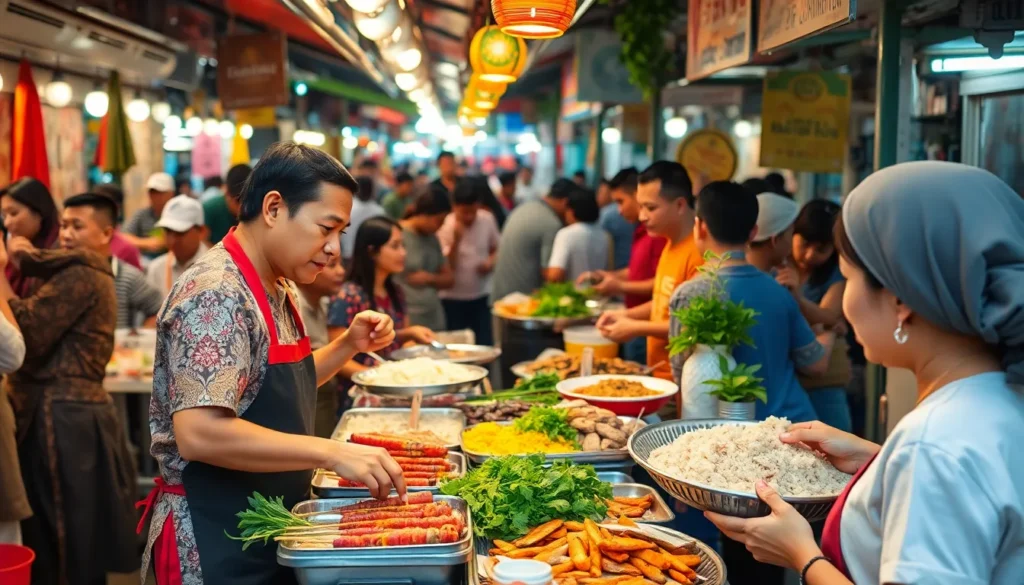Indonesia’s culinary landscape is a vibrant tapestry woven from diverse cultures and traditions. With over 17,000 islands, each region boasts its own unique flavors and cooking techniques, creating a gastronomic adventure that beckons food lovers from around the globe. From the spicy richness of Padang cuisine to the sweet and savory delights of Javanese dishes, every bite tells a story of Indonesia’s rich history and cultural heritage.
Street food stalls and bustling markets offer a sensory overload, where the aroma of grilled satay, fried rice, and fresh seafood fills the air. Indonesia’s food scene is not just about taste; it’s a celebration of community and togetherness. As one explores the archipelago, they’ll discover that each meal is an invitation to connect with the local culture, making Indonesia a must-visit destination for anyone seeking a culinary experience like no other.
Food in Indonesia
Food in Indonesia showcases a blend of flavor profile diversity from over 300 ethnic groups. Each group brings unique spices, ingredients, and cooking methods. The country’s vast geography influences local agriculture, allowing the use of various fresh produce and seafood.
Distinctive regional cuisines define Indonesian food. Sumatra features spicy Padang cuisine, known for dishes like Rendang, a slow-cooked beef curry with rich spices. Java offers the sweet-savory profile seen in dishes like Nasi Gudeg, made with young jackfruit and coconut milk. Bali introduces vibrant flavors through dishes such as Babi Guling, a whole roasted pig seasoned with spices.
Street food plays an integral role in Indonesian culinary culture. Vendors serve freshly prepared meals that include Nasi Goreng, fried rice cooked with a medley of ingredients, and Satay, marinated meat skewered and grilled to perfection. The social aspect of street food fosters community engagement, as people gather to share meals and stories around bustling markets.
Furthermore, traditional Indonesian cooking emphasizes fresh herbs and spices. Coriander, turmeric, galangal, and lemongrass frequently appear in dishes across regions, emphasizing health benefits while enhancing flavors.
Indonesia’s vibrant culinary scene highlights not only the country’s rich traditions but also its commitment to using locally sourced ingredients. The food is more than sustenance; it’s an experience that connects people to their cultural roots and traditions. As such, Indonesia stands out as a prime destination for culinary exploration.
Popular Dishes

Indonesia’s culinary scene boasts a range of popular dishes that highlight its regional diversity and rich flavors.
Nasi Goreng
Nasi Goreng represents Indonesia’s iconic fried rice dish, typically served as a flavorful entrée. The dish combines cooked rice with ingredients such as garlic, shallots, and chili, while incorporating proteins like chicken or shrimp. Soy sauce gives it a savory kick, and garnishes like fried eggs or cucumber enhance its presentation. Variations exist across regions, with some adding ingredients like tempeh or pickles, making Nasi Goreng a go-to meal for locals and visitors alike.
Rendang
Rendang originates from the Minangkabau ethnic group of West Sumatra and is a slow-cooked beef curry. Its base includes coconut milk and a mixture of spices such as lemongrass, galangal, and turmeric, resulting in a rich, aromatic flavor. Typically served with rice, rendang’s tender meat and savory sauce embody the essence of Indonesian cuisine. Cooked for several hours, the dish’s complex flavors deepen, making rendang a beloved choice during festive occasions and family gatherings.
Satay
Satay consists of skewered and grilled meat, commonly chicken, beef, or lamb, marinated in a mixture of spices. Vendors serve it alongside peanut sauce, which adds a rich, nutty flavor. The dish comes with accompaniments like rice cakes or cucumber slices. Street food vendors widely popularize satay due to its convenient serving style and delicious taste. Variations exist throughout Indonesia, with each region offering its unique twist on marinades and sauces.
Gado-Gado
Gado-Gado is a traditional salad combining blanched vegetables, boiled eggs, tofu, and tempeh, all drizzled with a rich peanut sauce. The dish is known for its delightful mix of textures and flavors, providing a balance of freshness and creaminess. Common vegetables include beansprouts, green beans, and cabbage. Gado-Gado reflects Indonesia’s emphasis on using fresh, local ingredients, making it a nutritious choice that appeals to vegetarians and meat-eaters alike.
Regional Cuisines
Indonesia’s regional cuisines reflect a rich tapestry of cultural influences and local ingredients. Each region showcases distinct flavors and cooking techniques, contributing to the nation’s culinary diversity.
Javanese Cuisine
Javanese cuisine is characterized by its sweet and savory flavors, often using ingredients like palm sugar and soy sauce. Popular dishes include Nasi Gudeg, a delectable jackfruit stew, and Sate Ayam, chicken skewers marinated in a rich soy sauce. Javanese meals generally emphasize balance, often including fresh vegetables and assorted side dishes. Street vendors prominently feature Javanese dishes, allowing for an authentic tasting experience.
Balinese Cuisine
Balinese cuisine offers bold and aromatic flavors, commonly featuring spices such as ginger, galangal, and chilies. Signature dishes like Babi Guling, a roasted pig, highlight the island’s culinary techniques. Nasi Campur, a mixed rice dish served with an assortment of meats and vegetables, reflects the diversity of ingredients. Balinese meals often accompany traditional ceremonies, showcasing food’s cultural significance.
Sumatra Cuisine
Sumatra cuisine is renowned for its spicy and fragrant dishes, heavily influenced by the Minangkabau culture. Rendang, a slow-cooked beef curry, stands out as a celebrated national dish. Other highlights include Soto Padang, a savory meat soup, and Ayam Pop, fried chicken with a unique spice blend. Sumatrans incorporate fresh herbs and spices, enhancing the robust flavors within their meals.
Sulawesi Cuisine
Sulawesi cuisine showcases a blend of influences due to its diverse ethnic groups. The region is famous for its seafood dishes, including Ikan Bakar, grilled fish seasoned with aromatic spices. Coto Makassar, a beef soup enriched with spices, offers a hearty option. Dishes from Sulawesi often feature rich sauces and are served with rice, emphasizing communal dining and shared experiences.
Street Food Culture
Street food in Indonesia plays a crucial role in the country’s culinary identity, showcasing an array of flavors and traditions. Vendors prepare a variety of dishes in bustling markets and streets, creating a vibrant atmosphere that reflects the local culture. Popular dishes include:
- Satay: Grilled skewered meat, often served with peanut sauce.
- Nasi Goreng: Iconic fried rice, typically topped with a fried egg.
- Gado-Gado: Salad featuring blanched vegetables and a peanut dressing.
- Bakso: Meatball soup served with noodles and tofu.
Street food highlights the use of fresh herbs and spices, essential in Indonesian cooking. Coriander, turmeric, and sambal (chili paste) contribute to the bold flavors that excite palates. Vendors often showcase traditional cooking methods, such as grilling and frying, attracting those seeking authentic culinary experiences.
Community gatherings revolve around street food stalls, emphasizing social interaction. Families and friends come together to enjoy meals, strengthening cultural bonds and fostering connections. Food markets, such as Jakarta’s Glodok or Bali’s Seminyak, serve as popular destinations for both locals and tourists looking to explore diverse flavors in one setting.
Safety and hygiene are critical considerations for consumers. Many vendors take pride in their clean cooking practices to build customer trust. While street food offers affordable options, it also presents opportunities for culinary innovation. Street chefs create fusion dishes that blend traditional flavors with modern influences.
Street food in Indonesia encapsulates the essence of the nation’s culinary heritage. It invites exploration, connection, and celebration of local ingredients, making it an integral part of the Indonesian experience.
Conclusion
Indonesia’s culinary landscape is a vibrant tapestry woven from its diverse regions and rich cultural heritage. Each dish tells a story of tradition and community, inviting food lovers to explore flavors that range from spicy to sweet. The bustling street food scene embodies the spirit of togetherness, where locals and visitors alike gather to savor freshly prepared meals.
The influence of over 300 ethnic groups ensures that every bite offers a unique experience, showcasing the use of fresh herbs and spices that elevate Indonesian cuisine. For those seeking a culinary adventure, Indonesia presents an irresistible array of flavors and traditions that leave a lasting impression.

